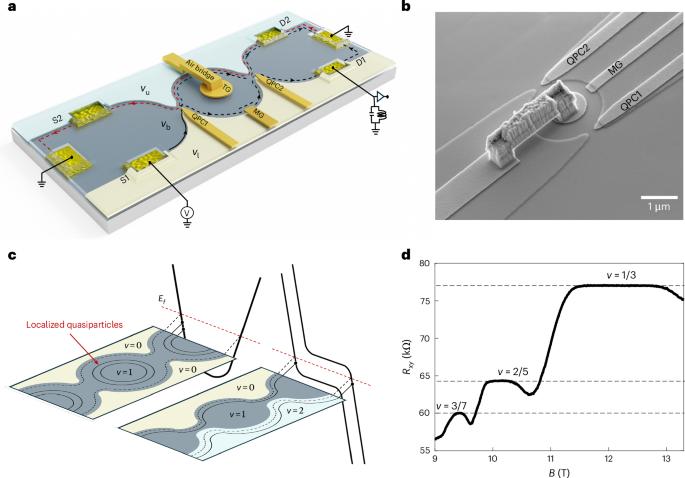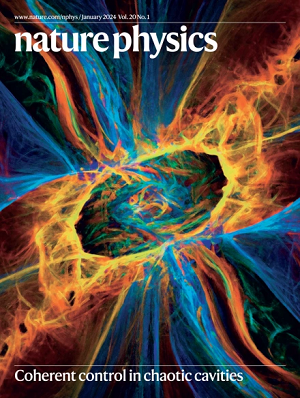Anyonic braiding in a chiral Mach–Zehnder interferometer
IF 18.4
1区 物理与天体物理
Q1 PHYSICS, MULTIDISCIPLINARY
引用次数: 0
Abstract
Fractional quantum statistics are the defining characteristic of anyons. Measuring the phase generated by an exchange of anyons is challenging, as standard interferometry set-ups—such as the Fabry–Pérot interferometer—suffer from charging effects that obscure the interference signal. Here we present the observation of anyonic interference and exchange phases in an optical-like Mach–Zehnder interferometer based on co-propagating interface modes. By avoiding backscattering and deleterious charging effects, this set-up enables pristine and robust Aharonov–Bohm interference without any phase slips. At various fractional filling factors, the observed flux periodicities agree with the fundamental fractionally charged excitations that correspond to Jain states and depend only on the bulk topological order. To probe the anyonic statistics, we used a small, charged top gate in the interferometer bulk to induce localized quasiparticles without modifying the Aharonov–Bohm phase. The added quasiparticles introduce periodic phase slips. The sign and magnitude of the observed phase slips align with the expected value at filling 1/3, but their direction shows systematic deviations at fillings 2/5 and 3/7. Control over added individual quasiparticles in this design is essential for measuring the coveted non-abelian statistics in the future. An interferometer design allows systematic investigation of the anyonic statistics of bulk fractional quantum Hall states.


手性马赫-曾德尔干涉仪中的任意子编织
分数量子统计是任意子的定义特征。测量由任意子交换产生的相位是具有挑战性的,因为标准的干涉测量装置——比如法布里-普氏干涉仪——会受到电荷效应的影响,从而模糊干扰信号。本文介绍了基于共传播界面模式的类光学马赫-曾德干涉仪中任意子干涉和交换相位的观测。通过避免反向散射和有害的充电效应,这种设置可以实现原始和强大的阿哈罗诺夫-玻姆干扰,没有任何相位滑移。在不同的分数填充因子下,观测到的通量周期与基本的分数带电激发相一致,这些激发与Jain态相对应,只依赖于体拓扑顺序。为了探测任意子统计量,我们在干涉仪体中使用一个小的带电顶栅来诱导局域准粒子,而不改变Aharonov-Bohm相。添加的准粒子引入周期性相滑移。在填充1/3处,观测到的相滑移的符号和大小与期望值一致,但在填充2/5和3/7处,相滑移的方向出现系统偏差。在这种设计中,对添加的单个准粒子的控制对于将来测量令人垂涎的非阿贝尔统计量是必不可少的。
本文章由计算机程序翻译,如有差异,请以英文原文为准。
求助全文
约1分钟内获得全文
求助全文
来源期刊

Nature Physics
物理-物理:综合
CiteScore
30.40
自引率
2.00%
发文量
349
审稿时长
4-8 weeks
期刊介绍:
Nature Physics is dedicated to publishing top-tier original research in physics with a fair and rigorous review process. It provides high visibility and access to a broad readership, maintaining high standards in copy editing and production, ensuring rapid publication, and maintaining independence from academic societies and other vested interests.
The journal presents two main research paper formats: Letters and Articles. Alongside primary research, Nature Physics serves as a central source for valuable information within the physics community through Review Articles, News & Views, Research Highlights covering crucial developments across the physics literature, Commentaries, Book Reviews, and Correspondence.
 求助内容:
求助内容: 应助结果提醒方式:
应助结果提醒方式:


